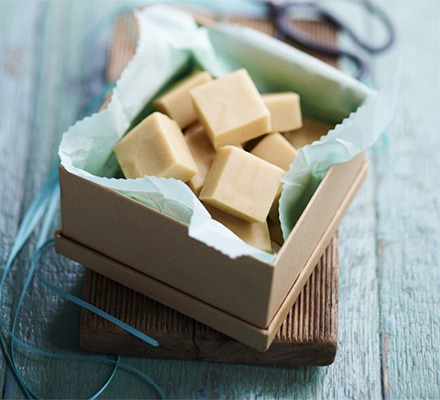Vanilla fudge
Homemade fudge makes a fabulous gift wrapped up for Christmas or any special occasion. Our recipe for these buttery sweets is well worth the effort
-
Prep:10 mins
Cook:40 mins
Plus overnight cooling - A challenge
Nutrition per serving
-
kcal 118
-
fat 7g
-
saturates 4g
-
carbs 13g
-
sugars 13g
-
fibre 0g
-
protein 0g
-
salt 0g
Ingredients
- 450g golden caster sugar
- 400g double cream
- 50g butter
- 1 tbsp glucose syrup
- 1 tbsp vanilla bean paste
Tip
Fudge know-how: sugar crystalsFudge gets its melt-in-the-mouth consistency from the small sugar crystals that are created by beating the mixture as it cools. If you beat the mixture before it has cooled to 110C, you will encourage larger crystals to form, which can result in a grainy texture.Fudge know-how: temperature
You need to be precise when making sweets and confectionery, so it’s worth investing in a sugar thermometer.Fudge know-how: best results
For the best result, beat the mixture until it has almost set, then pour into a tin and smooth over.
Method
Line a 20 x 20cm cake tin with baking parchment. Tip the sugar, cream, butter and glucose syrup into a medium to large saucepan. Heat to dissolve the sugar and melt the butter, stirring now and again.
Once dissolved, put a sugar thermometer in the pan, making sure the end is completely covered by the syrup – if not, transfer the mixture to a smaller pan (with enough space for the syrup to bubble up). Increase the heat and bring the syrup to a steady boil. Keep bubbling, stirring occasionally to stop the sugar from catching, until the mixture reaches 116C – this is known as the soft ball stage.
Remove the pan from the heat and leave to sit, undisturbed, for 5 mins, until the temperature drops to 110C. Stir in the vanilla and a good pinch of salt.
Keep the sugar thermometer in the pan and begin beating the mixture with a wooden spoon, quite vigorously, until the temperature cools to about 60C. By this time the fudge will be really thick and will have lost it glossy shine. Remove the thermometer and continue beating for a few mins more. This process is very important when making fudge, as it creates small sugar crystals, which give the fudge its lovely smooth and creamy texture (see 'fudge know-how', below).
Before it sets completely, quickly pour the fudge into your prepared tin and smooth over the surface. Leave to cool at room temperature overnight – don’t put the fudge in the fridge as it will become sticky and won’t set properly. Cut into bite-sized pieces and pop in a box to give as a present. Will keep, in a sealed container, for up to 2 months.





















